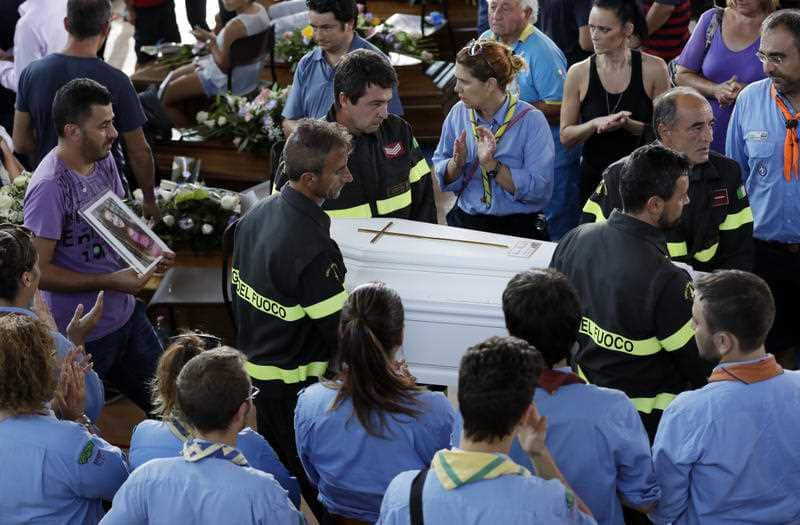As questions mount over the deaths of nearly 300 people, prosecutor Giuseppe Saieva indicated that property owners who commissioned suspected sub-standard work could be held responsible for contributing to the quake's deadly impact.
Saieva, who works in the Rieti region between Rome and the quake's epicentre, said the tragedy could not simply be filed away as an unavoidable natural disaster.
"If the buildings had been constructed as they are in Japan they wouldn't have collapsed," he told La Repubblica.
Within hours of the quake hitting on Wednesday Saieva was in Amatrice, the small mountain town hit hardest by the quake. He is inspecting the damage there before opening a preliminary investigation for possible culpable homicide and causing a disaster.
He is inspecting the damage there before opening a preliminary investigation for possible culpable homicide and causing a disaster.

The coffin of 9-year-old Giulia Rinaldo, is carried outside the gymnasium at the end of the state funeral service in Ascoli Piceno, Italy. Source: AAP
The crushed partition walls of a collapsed three-storey villa were among the sights that caught his eye. "I can only think it was built on the cheap with more sand than cement," he said.
A number of engineering and architectural experts have highlighted the widespread use of relatively cheap cement beams for house extensions and renovations as a possible factor explaining why so many buildings collapsed.
Heavy and inflexible, the cement beams become deadly if released by shaking because they will crush older walls beneath them.
"If it emerges that individuals cut corners, they will be pursued and those that have made mistakes will pay a price," the prosecutor said.
Centuries old problem
The issue of whether some of the deaths could have been avoided is particularly acute in the Amatrice area because it is so close (50 kilometres, 32 miles) to L'Aquila, which was hit by a 2009 earthquake in which over 300 people perished.
An outcry over the shoddy, corrupt building practices which led to so many buildings in the university city being inadequately prepared for a quake led to the national Civil Protection agency making almost one billion euros ($1.2 billion) available for upgrading buildings in quake-vulnerable areas.
But the take-up of grants has been low. Critics blame bureaucracy but others maintain that independent-minded villagers will always find the cheapest way of getting their renovations done, whatever the risks.
Some 40 percent of the Italian population, 24 million people, live in zones vulnerable to earthquakes and the risk that entails has been a subject for the country's finest minds for centuries.
As early as the first century, an advisor to the emperor Vespasian, Pliny the elder, was making recommendations on how buildings could be designed to withstand tremors.
And the thicker walls and stone piers that are features of many modern-day quake-proof buildings, were also included in plans drawn up by Renaissance architect Pirro Ligorio in the late 16th century, after southern Italy was devastated by an earthquake that caused 2,000 deaths.
- Huge bill -
Experts however say protecting Italy's unrivalled artistic and architectural heritage is far from straightforward.
"If we start from the idea of upgrading every old building to comparable safety levels of a modern building built to anti-seismic norms, we have to accept that we will never get there," said Paolo Bazzurro, a professor in construction techniques at the University of Pavia.
The trend away from traditional wooden roofs and beams is not the only problem: widening window openings and the removal of reinforcing chains embedded in walls have also contributed.
"These things make buildings more vulnerable," said Bazzurro.
Prime Minister Matteo Renzi has promised to rebuild the hilltop villages devastated by the quake. There will be no repeat of a failed attempt to replace the old communities with new towns elsewhere, which happened after L'Aquila.
"There are lots of technically feasible things that can be done and do not require huge interventions," said Culture Ministry expert Paolo Iannelli.
"Given that towns in the seismic areas have acquired a knowledge of what works over the centuries and generally used the most appropriate materials, it is a question of correcting renovations that have been done over time and have impacted on the resistance of the buildings," he told AFP.
Better and more regular checks on the impact of rain on foundations would be one area where the state could improve its controls, he added.
For houses built before anti-seismic measures became the norm in 1970, it is relatively easy to install shock absorbers, experts say.
But a comprehensive solution will not come cheap. Infrastructure Minister Graziano Delrio was asked last week how much it would cost to bring every building in Italy up to modern anti-quake standards. His answer: 360 billion euros.


